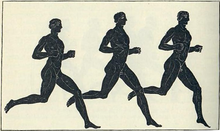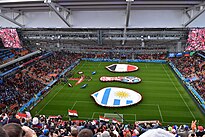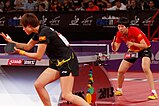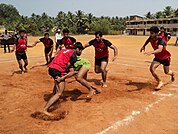Western physical culture
Western physical culture is the form of physical culture that originated mainly in the West.
History
Ancient era

The practice of calisthenics by the ancient Greeks,[1] as well as the way in which sport was a major part of their society, as seen in events such as the Ancient Olympic Games and the way in which sport featured in domains such as poetry and religion,[2] served as a foundation for modern Western physical culture.[3]
Many current rural games in the West are believed to have originated as pagan practices from around the time of the ancient Greeks onward.[4]
Medieval era
The ancient Olympics came to an end around the late 5th century CE partially due to changing cultural tastes that were influenced by the uptake of Christianity throughout Europe, though broader claims that are often made of Christianity having been wholly responsible for the end of the ancient Olympics have been debunked.[5] Christians continued to practice sports during feast days, holy days and Sundays throughout the medieval era.[6] However, gymnasium cultures declined in Europe up until the Renaissance,[7][8] though the utilitarian war-oriented tradition of ancient Spartan and Roman training methods, which contrasted with the broader humanistic educational background that most ancient Greek physical cultural forms were offered in, remained relevant.[9]
Modern era

The physical culture movement in the United States during the 19th century owed its origins to several cultural trends.[11]
In the United States, German immigrants after 1848 introduced a physical culture system based on gymnastics that became popular especially in colleges. Many local
By the late 19th century reformers worried that sedentary white collar workers were suffering from various "
Physical culture programs were promoted through the education system, particularly at
Industry began the production of various items of exercise-oriented sports equipment. During the early and mid-19th century, these printed works and items of apparatus generally addressed exercise as a form of remedial physical therapy.
Certain items of equipment and types of exercise were common to several different physical culture systems, including exercises with Indian clubs, medicine balls, wooden or iron wands and dumbbells.
were also widely practiced in physical culture schools and were touted as forms of physical culture in their own right. The Muscular Christianity movement of the late 19th century advocated a fusion of energetic Christian activism and rigorous physical culture training.Relationship with various movements
Christianity
Western physical culture experienced some suppression in the late medieval era as a result of
Militarism and imperialism
The battle of Waterloo was won on the playing fields of Eton.
In
Throughout the early and middle 20th century, a greater usage of machinery in warfare made battlefields devoid of clumped-up masses of soldiers, which made individual soldiers more important, and increased the odds that soldiers had to brave in order to successfully kill enemies; in addition,
Muscular religious nationalism

During the colonial era, Western ideas around masculinity, as well as the way in which accusations of effeminateness against Western colonial subjects were employed, encouraged the growth of muscular religious movements throughout the world.
Nation-building and international community

The spread of
Developing countries have often encouraged greater participation in Western sports in part to have greater relevance on the world stage.[29] Western sports have also served as part of the post-colonial nation-building process in many non-Western countries.[30][31][32]
Straight white male supremacy
Western physical culture sometimes intertwined with broader gender-, sexuality- and race-related conflicts, such as eugenics,[33] in Western countries.[34][35] Homosexual people were seen as to be reviled during the peak of European imperialism, at a time when there was a dispersal of messaging about the need to reclaim masculinity through muscularity and the execution of a "regenerative violence" throughout the world.[21] Women who succeeded in sports were often seen as less womanly, as fitting into a paradigm that centered around masculinity in sports.[36]
Within the United States, Western physical culture supplanted Native American ideas about physical culture, with Native American women in particular being historically seen as bound to be physically weak without white intervention.[37] In Canada, indigenous peoples sometimes used equestrian activities like rodeo to showcase their athletic prowess in relation to European settlers.[38]
Influence on the world
Western physical culture greatly influenced the world during and after the colonial era. The practice of colonialism itself was underpinned by Western ideas regarding masculine fitness or absence thereof throughout the world; for example, the British felt that many peoples of the world were physically unfit, and therefore incapable of governing themselves.[41][21]
Africa
The colonization of Africa resulted in a deep marginalization of traditional African games, with Western physical culture having been imposed to a significant extent. One reason for this was the imperial desire to stamp out militaristic training activities that had been prevalent among the native population.[42] Christian missionaries disseminated Western physical culture throughout Africa through the schooling systems, with the general belief that Western civilization should supplant the native culture because it was superior and more rational being a driving force;[43][44] local games were seen as primitive and immoral.[45]
African subjects were seen as having a natural strength greater than white men, but at the same time, white men's supposed superior physical discipline was used as a way of explaining Western dominance over Africa.[46] In South Africa, Western sports were simultaneously included within the purview of apartheid policies and a vector of demonstration for anti-apartheid sentiments and performances.[47]
Asia
Various
East Asia
China

Western physical culture was brought into China with an initial element of Western military force backing its entry into Chinese society,[50] and was introduced during the 19th-century Qing dynasty in the form of military drills, Western-style schooling, and Christian missionary influences by organizations such as the YMCA.[51][52] The shock from the encounter with the West forced Chinese academics to debate the way in which the Western ideas surrounding physical culture should be adopted into Chinese society, with some calling for the end of "moribund" Chinese traditions.[53]
Western physical culture contrasted with and overtook native Chinese physical culture to a significant extent, with Western physical culture encouraging a greater level of competitiveness, whereas Chinese physical culture, influenced by anti-physical
Japan
Western physical culture's introduction into Japan occurred in a relatively haphazard way, with a variety of Western professors, military personnel, and others teaching various sports to the Japanese.[27]
South Asia

Modern yoga originated from the colonial-era interaction between Western physical culture and pre-existing forms of hatha yoga in India,[61][62] and grew as South Asians sought to combat British perceptions of Indian men as effeminate by fusing Western bodybuilding methodologies with indigenous traditions.[63][64] The formation and propagation of modern yoga has led to what some have argued as being the neglect of the non-bodily aspects of yoga.[65]
The
Southeast Asia
In Laos, Western ideas around sport were introduced by applying Buddhist cultural conventions surrounding discipline and merit to physical fitness.[74]
West Asia
Influences from the non-West
References
- PMID 27695277.
- JSTOR 10.3138/j.ctvpmw44f.
- ERIC EJ1086323.
- ISBN 978-92-3-104083-2.
- ^ Magazine, Smithsonian; Gabriele, David M. Perry,Matthew. "What the Medieval Olympics Looked Like". Smithsonian Magazine. Retrieved 2024-03-19.
{{cite web}}: CS1 maint: multiple names: authors list (link) - ISBN 978-0-8091-4795-3.
- ISBN 978-1-957792-23-1.
- ISBN 978-1-135-77324-3.[page needed]
- ^ ISBN 978-0-7006-3258-9.
- Gale A655088504.
- ^ Shelly McKenzie, Getting Physical: The Rise of Fitness Culture in America (University Press of Kansas; 2013)
- ^ Gertrud Pfister, "The Role of German Turners in American Physical Education," International Journal of the History of Sport (2009) 26#13 pp 1893-1925.
- ^ a b McLeod, Hugh (2023-03-01). "How sport became the new religion – a 200-year story of society's 'great conversion'". The Conversation. Retrieved 2024-03-19.
- ^ a b McKay, Brett and Kate (2016-09-13). "When Christianity Was Muscular". The Art of Manliness. Retrieved 2024-03-22.
- ISBN 978-0-415-89922-2.
- .
- hdl:10520/EJC19564.
- ISBN 978-0-19-928052-0.
- ISBN 978-1-349-39337-4.
- .
- ^ ISSN 0261-3077. Retrieved 2024-03-21.
- JSTOR 3830190.
- ^ Pringnitz, Keelin (2023-04-04). Shame, Modesty, Identity: Lived Religion In Athletic Spaces (Thesis thesis). Université d'Ottawa / University of Ottawa.
- ^ "The emergence of modern Hinduism: religion on the margins of colonialism". Library of Congress, Washington, D.C. 20540 USA. Retrieved 2024-02-17.
- OCLC 0803213557.
- ISBN 978-1-003-12179-4.
- ^ a b Reischauer, Edwin O. "A UNION OF TWO WORLDS". Sports Illustrated Vault | SI.com. Retrieved 2024-03-20.
- .
- .
- .
- S2CID 159173362.
- .
- JSTOR 45390291.
- .
- .
- OCLC 48769301.[page needed]
- hdl:2142/105606.[page needed]
- .
- ^ Aripaka, Rahul (2023-04-30). "IPL: How India became home to the biggest, baddest cricketing league in the world". The Economic Times. Retrieved 2024-03-18.
- ^ a b Love, Adam; Dzikus, Lars (2020-02-26). "How India came to love cricket, favored sport of its colonial British rulers". The Conversation. Retrieved 2024-03-18.
- ISBN 978-1-928480-69-3.
- ISBN 978-1-351-21273-1.
- JSTOR 24764244.
- .
- ^ Amusa, L. O.; Toriola, A. L. (2010). "The changing phases of Physical education in Africa: Can a uniquely African model emerge?". African Journal for Physical Activity and Health Sciences. 16 (4).
- ISBN 978-0-8147-1267-2.
- ISBN 978-1-928480-68-6.
- ^ .
- ^ "Once a tool for diplomacy, table tennis now viewed by China as so much more". NBC News. 2021-08-06. Retrieved 2024-03-18.
- .
- ISBN 978-1-84520-101-2.
- ISBN 978-1-315-21076-6.
- ISBN 978-0-226-07646-1.
- .
- ^ Tang (湯志傑), Chih-Chieh. "Yundong One Term for Two Different Body Cultures". The First International Conference for the Sociology of Sport, Taiwan (Taoyuan: National Taiwan Sport University & the Taiwan Society of Sport Sociology).
- ProQuest 1916572523.[page needed]
- ISBN 978-0-520-24084-1.[page needed]
- .
- S2CID 134272454.[page needed]
- .
- ISBN 978-0-19-008273-4.[page needed]
- ISBN 978-0-19-539535-8.
- ^ "A Brief History of Modern Yoga". TheCollector. 2022-07-05. Retrieved 2024-03-18.
- ISBN 978-0-19-539535-8.
- PMID 38311913.
- .
- ^ Ramachandran, Aishwarya (2019). Counterflows of knowledge: the transnational circulation of physical culture practices between India and the West during the early 20th century (Thesis). University of British Columbia.
- ISBN 978-0-429-43101-2.
- ^ Baier, Karl. Modern Yoga Research (Report).
After his stay in the United States, Vivekananda promoted the importance of building up physical strength for the spiritual development of Hindus.
[self-published source?] - ISBN 978-1-003-08677-2.
- ProQuest 1314798814.[page needed]
- ^ "Muscular Christianity in Colonial and Post-Colonial Worlds". Reviews in History. Retrieved 2024-03-19.
- ^ "'The Revenge of Plassey': Football in the British Raj". LSE International History. 2020-07-20. Retrieved 2024-03-19.[self-published source?]
- S2CID 165122180.
- .
